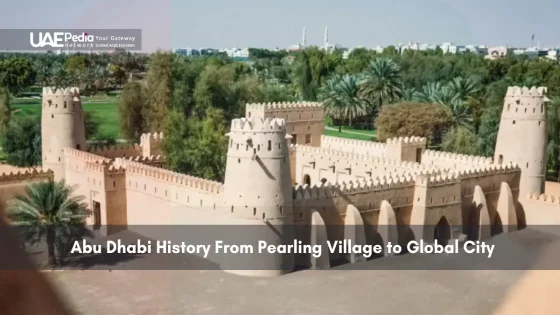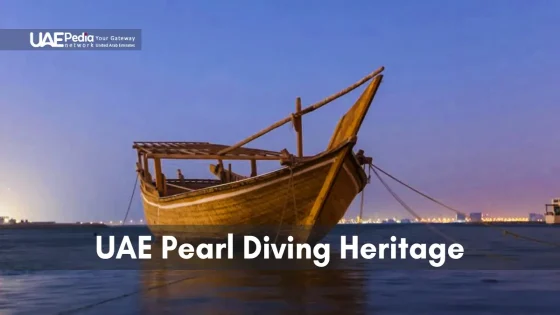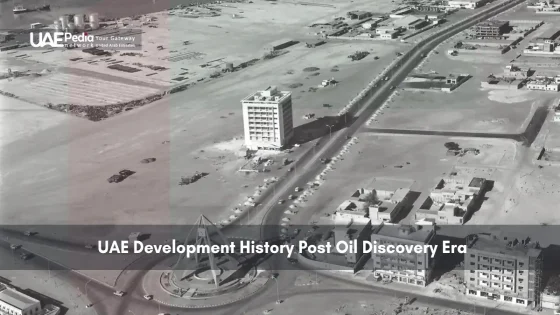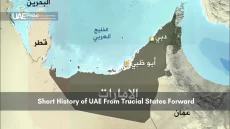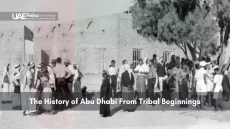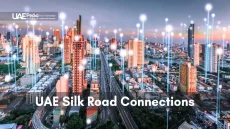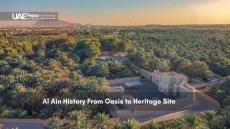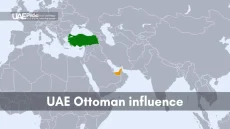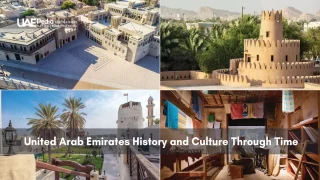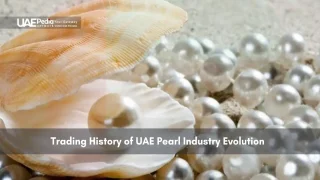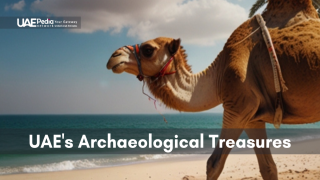What if a quiet coastal village could become a global powerhouse in under a century? That’s the story etched into the sands of this desert-meets-sea marvel—a place where pearl divers once anchored wooden dhows now docked beside glass skyscrapers.
Long before futuristic museums and Formula 1 races, life here pulsed to the rhythm of the tides. Archaeologists found stone tools near Jebel Hafeet suggesting settlements over 7,000 years old. By the 18th century, the Bani Yas tribe—led by the Al Nahyan family—turned these shores into a pearling hub, their wooden boats dotting the Gulf like scattered shells.
Everything changed when oil whispers became a roar in 1958. Visionary leadership by Sheikh Zayed bin Sultan Al Nahyan transformed black gold into infrastructure gold: hospitals, schools, and that iconic skyline. Yet walk through the Qasr Al Hosn fort today, and you’ll still smell frankincense wafting beside latte art cafes—tradition and progress sharing one sun-drenched table.
Key takeaways:
- From ancient tools to modern towers, this city’s roots stretch deeper than its tallest buildings
- Pearl diving tribes laid groundwork for leaders like Sheikh Zayed to build a 21st-century oasis
- Oil wealth became a bridge between Bedouin heritage and global ambition
Ancient Beginnings and Pearling Traditions
Imagine diving into turquoise waters not for Instagram, but for survival—this was daily life along these shores long before skyscrapers. Beneath the modern city’s glow lies a layered past, where ancient traders and pearl divers carved stories into the land.
Archaeological Evidence and Early Settlements
Dig into the dunes near Jebel Hafit, and you’ll find clues to a 5,000-year-old puzzle. The Umm Al Nar culture left behind circular tombs and pottery shards, proving communities thrived here millennia ago. Freshwater springs allowed date palms to flourish, creating oases that drew nomadic tribes like magnets.
These early residents weren’t just surviving—they were trading. Bronze Age artifacts reveal connections stretching from Mesopotamia to the Indus Valley. Their stone tools and irrigation systems whisper, “We built more than camps; we built foundations.”
The Legacy of Traditional Pearl Diving
Picture this: summer mornings where divers gulped air before plunging 30 meters on a single breath. Pearls weren’t luxury items then—they were currency. Crews spent months at sea, braving jellyfish stings and dehydration to fill woven baskets.
The Al Nahyan family, ancestors of Sheikh Zayed bin Sultan Al Nahyan, organized these dangerous expeditions. Villages buzzed with pearl auctions, where merchants haggled over iridescent treasures. This risky trade forged tight-knit communities—every sailor’s success meant food for someone’s family.
Today, you can still touch this heritage. Run your fingers over weathered diving weights at Qasr Al Hosn, or hear elders mimic the sailors’ work songs. The Gulf’s pearls may have lost their economic shine, but their cultural luster? That’s forever.
The Evolution of Abu Dhabi’s Settlement
How does a scattered desert tribe lay the foundation for a metropolis? The answer lies in the grit of the Bani Yas people, whose leadership and unity transformed arid sands into a thriving settlement. Their story isn’t just about survival—it’s a masterclass in turning vision into reality.
The Role of the Bani Yas Tribe
Picture this: nomadic families navigating dunes, guided by stars and ancestral wisdom. The Bani Yas tribe didn’t just adapt to the harsh environment—they mastered it. Settling on the coast in the 1760s, they leveraged maritime trade and freshwater springs to build a permanent home. Leaders like Sultan bin Nahyan fostered alliances, creating a web of trust that turned competing clans into collaborators.
One elder’s account recalls, “We didn’t just share water—we shared futures.” This communal ethos allowed the tribe to flourish, laying groundwork for governance structures that still shape the region today.
The Emergence of Qasr Al Hosn
In 1793, a watchtower rose from the island’s heart—Qasr Al Hosn. Built from coral and sea stone, it became the Nahyan family’s seat of power. Over decades, the fort expanded into a palace, its walls witnessing strategy sessions that balanced tribal traditions with emerging trade opportunities.
Inside those storied rooms, figures like Zayed bin Sultan navigated shifting alliances. The fort wasn’t just a building—it was a living symbol of stability. Today, its restored corridors whisper tales of pearl merchants and poetry nights, proving that even skyscrapers need roots.
Exploring abu dhabi history: From Humble Beginnings to Prosperity
What secrets lie in the sands where camel caravans once traced paths now crossed by highways? The 1700s sparked a quiet revolution here—freshwater springs bubbling beneath dunes became lifelines for growth. By 1761, the Bani Yas tribe’s leaders established permanent governance, their decisions echoing through the Al Nahyan family’s still-active legacy.
Key Milestones in the 18th and 19th Centuries
1793 marked a turning point. Watchmen climbed Qasr Al Hosn’s new coral-stone towers, scanning horizons for trade ships. Freshwater wells near Liwa Oasis turned seasonal camps into year-round hubs. “Water didn’t just quench thirst—it fueled ambition,” notes a 19th-century trader’s journal.
Pearl merchants transformed the coastline by the 1820s. Dhows carried iridescent treasures to Bombay and Baghdad, while date palm farms expanded inland. Tribal councils evolved into structured leadership under Zayed bin Khalifa Al Nahyan, whose 1855 reforms stabilized trade routes.
By 1892, British treaties reshaped maritime security, protecting pearling fleets. Though oil remained decades away, these years wove resilience into the region’s fabric. Schools of wooden boats still dock where mega-tankers now anchor—proof that yesterday’s risks built today’s skyline.
The Impact of Oil Discoveries and Economic Expansion
Black gold gushed from the desert in 1958, rewriting the region’s destiny overnight. Where pearl divers once anchored wooden dhows, engineers now mapped oil reservoirs deep beneath the sands—a seismic shift that turned scarcity into abundance.
Early Oil Finds and Infrastructure Development
Geologists struck liquid fortune after years of risky surveys. The 1930s saw early exploration deals, but the real jackpot came when PDTC drilled Umm Shaif in 1958. Suddenly, the Al Nahyan family faced a challenge: how to turn underground wealth into above-ground progress.
Sheikh Zayed’s government became architects of modernity. Oil revenues built hospitals along trade routes where camel caravans once passed. Schools replaced pearl markets, and a new port welcomed supertankers where fishermen once cast nets. “We didn’t just pump oil—we pumped hope,” one engineer recalled from those heady days.
Transition from Pearling to Petroleum Wealth
The Gulf’s pearling fleets had collapsed by the 1950s, victims of cultured pearls and economic tides. But the region’s maritime trade networks proved adaptable. Former divers trained as rig operators, their breath-holding skills swapped for welding torches.
Strategic family decisions turned oil into lasting capital growth. Revenues funded roads connecting coastal hubs to inland oases, while airports linked the emirate to global markets. Today’s glittering skyline isn’t just steel and glass—it’s the physical form of a bold economic bet that paid off.
Architectural Marvels and Iconic Landmarks
Abu Dhabi’s skyline tells twin tales—one carved in centuries-old Islamic geometry, the other etched in futuristic steel. Here, minarets and spires share horizons, creating a visual dialogue between reverence and innovation.
Sheikh Zayed Grand Mosque: Where Geometry Meets Grace
Step into the world’s third-largest mosque, where 1,096 columns swirl like desert dunes frozen in marble. Built over 11 years with artisans from 38 countries, this masterpiece blends Moroccan archways and Turkish mosaics with laser-cut floral patterns. “We wanted a structure that whispers ‘peace’ in every language,” shared a lead architect. Its 82 domes glow at night—moonlight bouncing off glass tiles from Italy and gold-leaf calligraphy.
Touching the Sky Without Losing Ground
Just 15 minutes away, Etihad Towers’ curved facades mirror shifting sands, while Aldar HQ’s circular design nods to ancient coins. These architectural wonders aren’t just tall—they’re smart. Solar-responsive glass cuts energy use by 35%, proving tradition and tech can coexist.
The ruling family’s vision shines through each project. From the mosque’s Quranic inscriptions to Burj Mohammed’s abstract falcon motifs, every line honors the people’s heritage. As one engineer put it: “We build upward, but our foundations? Those stretch back to the first desert settlements.”
- Grand Mosque stats: 30,000-ton foundation, 24-karat gold chandeliers, 17,000㎡ of hand-knotted carpets
- Modern feats: 92-floor Capital Gate leans 18° westward—four times Pisa’s tilt
- Cultural thread: 21st-century towers use wind towers (barjeel), ancient cooling systems
Urban Planning and Modern Infrastructure
Bridges here don’t just cross water—they connect centuries. Where pearl divers once navigated tidal currents, eight-lane highways now hum with synchronized traffic lights. The Nahyan family saw roads as more than pavement: they’re threads weaving tradition into tomorrow’s blueprint.
Innovative Bridge Projects and Road Networks
Take the Sheikh Zayed Bridge—its undulating arches mimic desert dunes while handling 60,000 cars daily. This isn’t just engineering; it’s poetry in steel. “We wanted landmarks that move people both physically and emotionally,” shared a planner involved in the 2008 project. Saadiyat Island’s network of causeways doubles as flood barriers, proving infrastructure can multitask.
Smart traffic systems adapt to rush hours like seasoned conductors. Sensors adjust signals in real-time, slashing commute times by 25%. The E11 highway—dubbed the ‘Spine Road’—stretches 250km, linking the United Arab Emirates’ western reaches to Dubai. Former camel trails now host electric vehicle charging stations, a nod to sustainable progress.
Under Khalifa bin Zayed’s leadership, the emirate prioritized pedestrian-friendly designs. Shaded walkways mirror ancient souk corridors, while cycle paths follow old pearl trading routes. Even the airport’s runway angles were calculated using star patterns once guiding Bedouin navigators. Here, every asphalt ribbon honors history while racing toward horizons.
Cultural Heritage and National Identity
How does a leader’s vision become the soul of a nation? Walk through the emirate today, and you’ll find the answer etched into marble monuments and buzzing tech hubs alike—a living testament to Sheikh Zayed’s dream of unity through shared heritage.
The Legacy of Sheikh Zayed and National Unity
Sheikh Zayed didn’t just build roads—he built bridges between traditions. His famous decree, “A nation without a past is a nation without a present or future,” sparked initiatives preserving Bedouin poetry alongside AI museums. Step onto Yas Island, and you’ll see his philosophy in action: Ferrari World’s red curves mirror desert dunes, while nearby heritage villages host henna artists using ancient patterns.
Sheikh Khalifa bin Zayed Al Nahyan continues this legacy. Under his leadership, the emirate launched the Zayed National Museum—a falcon-shaped archive celebrating tribal diplomacy. Annual events like the Qasr Al Hosn Festival turn history into hands-on experiences, where kids race robotic camels and elders share folktales.
Three cultural cornerstones define modern identity here:
- Grand mosques where GPS-guided tours explain Islamic geometry
- Neon-lit souks selling frankincense next to smartwatches
- Public art installations quoting 14th-century poets in augmented reality
This blend of old and new isn’t accidental. As one architect told us: “We design skyscrapers that whisper our ancestors’ names.” From Sheikh Khalifa’s mangrove conservation projects to the Louvre Abu Dhabi’s rain-of-light dome, every innovation roots itself in timeless values. The result? A national identity as layered as the desert sands—and just as enduring.
Integration into the United Arab Emirates
What transforms seven emirates into a global powerhouse? Look no further than the coastal capital that became the glue binding tradition and progress. When the UAE formed in 1971, this emirate didn’t just join—it helped rewrite the region’s playbook.
The Al Nahyan family steered the federation like seasoned navigators. Oil revenues funded hospitals and schools across emirates, while its strategic island locations became trade gateways. “Unity isn’t about losing identity—it’s amplifying shared strengths,” remarked a founding diplomat.
Three pillars cemented its leadership role:
- Balancing tribal councils with modern ministries
- Investing in desalination tech to turn seawater into lifelines
- Using coastal island hubs like Saadiyat for cultural diplomacy
| Resource | Economic Impact | Global Initiative |
|---|---|---|
| Oil & Gas | 65% of UAE’s GDP | ADNOC sustainability partnerships |
| Water Tech | 12 desalination plants | World Water Council membership |
| Island Networks | $22B tourism revenue | Louvre Abu Dhabi collaborations |
Today, the government brokers climate deals and hosts UN conferences—all while preserving Bedouin dispute-resolution practices. Its mangroves get as much protection as tech startups, proving environmental care spans centuries.
From hosting Formula 1 races to funding Mars missions, this emirate bridges desert wisdom with world-class ambition. Walk along the Corniche at sunset, and you’ll see dhows and yachts sharing the harbor—a perfect metaphor for how tradition and innovation sail together here.
Government Evolution and Administrative Growth
How do ancient tribal councils evolve into ministries steering a global economy? The answer unfolds through decades of thoughtful reforms, where leaders transformed open-air discussions into data-driven policies. At the heart lies a balance—honoring traditions while embracing systems that fuel progress.
In the 1950s, decisions flowed through majlis gatherings—communal meetings under palm-frond shades. Today, glass-walled ministries analyze global trends using AI. Yet the core principle remains: leaders listen first. As one advisor noted, “We upgraded tents to boardrooms, not values.”
From Sand to Smart Governance
Three pillars define this transformation:
| Governance Era | Key Features | Symbolic Structure |
|---|---|---|
| Traditional Majlis (pre-1960s) | Consensus-based decisions, oral agreements | Palm-frond shelters |
| Modern Councils (1971–2000) | Specialized departments, written policies | Qasr Al Hosn restoration |
| Future Initiatives (2020s+) | AI-driven analytics, sustainability targets | Al Bahr Towers’ responsive facades |
Iconic buildings tell this story. The Presidential Palace blends Islamic arches with biometric security—stone lattices inspired by pearl divers’ baskets filter sunlight onto solar panels. Tribal values shape digital ID systems too: family networks inform social service algorithms.
Leaders like Sheikh Zayed ensured pearling-era resilience became today’s economic agility. Ministries now cluster on islands where dhows once docked, their strategies as interconnected as old trade winds. Progress here isn’t about erasing the past—it’s building smarter foundations atop ancient wisdom.
The Role of International Trade and Global Connections
The sea never sleeps here—it’s carried fortunes on its tides for centuries. Long before GPS-tracked cargo ships, wooden dhows navigated by stars connected this coast to India and Mesopotamia. Today, supertankers follow those same currents, proving trade isn’t just business here—it’s coded into the region’s DNA.
Early fishing fleets and pearl merchants built the first trade networks. Ship logs from 1820 show salted fish reaching Zanzibar, while pearls dazzled European royals. “Our boats carried more than goods—they carried trust,” notes a merchant’s journal in the National Archives. By 1900, over 300 pearling ships operated from these shores.
Modern trade wears a different face but keeps familiar rhythms. Where divers once harvested oysters, pipelines now transport 3 million barrels of oil daily. Ports like Khalifa handle 15 million containers yearly—triple their 2005 capacity. Strategic partnerships with the EU and China fuel innovation hubs, blending ancient barter savvy with blockchain tech.
Three shifts define this evolution:
- From monsoon-dependent voyages to AI-optimized shipping lanes
- Local fish markets expanding into global halal food exports
- Pearl valuation methods inspiring today’s commodity trading algorithms
Customs records reveal how 19th-century pearl earnings funded the first schools—a tradition continuing as trade revenues now bankroll space programs. With 80% of GDP tied to international commerce, the emirate’s future sails on winds it’s harnessed for millennia. Next time you see a skyscraper’s lights reflected in the Gulf, remember: they’re mirroring a trade legacy as old as the waves below.
Shifts in Demographics and Urban Development
In 1960, you could fit the entire population into a single football stadium. Today, they’d fill 140. This dizzying growth—from 25,000 residents to over 3.5 million—has reshaped the emirate’s skyline and social fabric. Where date farms once stretched, you’ll now find eco-friendly skyscrapers housing global talent.
Population Growth and Modern Settlement Patterns
The numbers tell a story of transformation. Between 1975 and 2023, urban areas ballooned from 15 km² to 972 km²—that’s 64 Manhattans of new development. Smart planning turned challenges into triumphs: 93% of residents now live within 500 meters of green spaces, despite the arid climate.
Visionary leadership steered this expansion. The emirate’s ruler implemented housing initiatives ensuring 85% of citizens own homes, while historical legal frameworks evolved to support mixed-use neighborhoods. “We build communities, not just buildings,” remarked a senior urban planner in 2022.
Three factors define this urban revolution:
- Satellite cities like Khalifa and Masdar absorbing 40% of new residents
- AI-powered traffic systems reducing commute times by 31% since 2015
- Traditional family compounds preserved amid glass towers
Even with neon-lit high-rises, you’ll spot elders sipping Arabic coffee in shaded courtyards. The emirate’s ruler calls this blend “progress with roots”—where smart metros whisk commuters past souks selling handmade saffron. As one lifelong resident joked, “My GPS knows 12 shortcuts, but my heart still follows the old sand paths.”
Reflecting on Abu Dhabi’s Journey into the Future
Where pearl divers once charted unknown waters, innovators now map smart cities beneath the stars. The emirate’s story—from Bedouin resilience to Mars mission sponsorships—proves heritage isn’t just preserved here; it’s the fuel for tomorrow. Sheikh Khalifa bin Zayed Al Nahyan’s leadership continues this legacy, blending ancestral wisdom with AI-driven urban plans.
New projects echo the past while racing forward. Masdar City’s carbon-neutral labs rise where date palms once shaded traders. The Louvre Abu Dhabi’s dome filters sunlight like ancient wind towers, its galleries bridging civilizations. Even mangrove conservation efforts mirror pearl divers’ respect for nature’s balance.
Three threads weave the city’s future tapestry:
- Solar farms powering 60% of needs by 2035
- Hyperloop networks shrinking desert travel to minutes
- AI-curated cultural festivals celebrating Emirati poets and holographic art
Walk Corniche Beach at dawn, and you’ll spot fishermen casting nets alongside engineers testing tidal turbines. This harmony of tradition and tech defines the emirate’s path. As Sheikh Khalifa often notes: “Our ancestors navigated by stars—we’ll navigate by them too, just with better tools.”
The city’s skyline keeps rewriting itself, but its soul remains rooted in sands where pearl divers first dreamed big. Ready to watch the next chapter unfold? Pack your curiosity—Abu Dhabi’s story is far from finished.
Archaeologists have uncovered Umm an-Nar tombs, stone tools, and pottery fragments dating back over 5,000 years. These finds reveal early trade links with Mesopotamia and Indus Valley civilizations, proving the region wasn’t just a desert backwater.
The Bani Yas tribe’s leadership under the Al Nahyan family transformed Abu Dhabi from a seasonal pearling camp into a strategic hub. Their 1793 move to the island solidified its role as the emirate’s political and economic heart.
Built in the 1760s as a watchtower, Qasr Al Hosn became the ruling family’s residence and administrative center. Its coral-stone walls symbolize the shift from nomadic life to a settled society, anchoring the city’s early governance.
After the 1958 offshore oil strike, revenues funded roads, hospitals, and schools. Traditional barasti huts gave way to concrete homes, and camel caravans were replaced by Land Rovers—literally reshaping the landscape within a generation.
Sheikh Zayed bin Sultan Al Nahyan, Abu Dhabi’s ruler from 1966, pioneered the UAE’s 1971 federation. His vision blended Bedouin values with modern governance, using oil wealth to uplift all emirates while preserving cultural identity.
The Sheikh Zayed Grand Mosque merges Mughal and Fatimid designs with 21st-century tech—its 82 domes glow with Macedonian marble. Meanwhile, the Louvre Abu Dhabi’s “rain of light” dome nods to ancient palm-frond roofing techniques.
Projects like Al Hosn Festival revive pearl-diving skills and falconry, while urban plans mandate wind towers in new buildings. The city expands upward and outward but keeps heritage districts car-free to honor walkable old neighborhoods.
Japan’s 1930s cultured pearl industry crashed Gulf markets. Combined with drought and WWII trade disruptions, this forced many into poverty—until oil turned Abu Dhabi into an energy titan almost overnight.
From Masdar City’s clean-tech partnerships to hosting Formula 1’s fastest track, Abu Dhabi links tradition with global networks. Its free zones attract multinationals, while Saadiyat Island’s museums create a cultural crossroads.
From 25,000 residents in 1960 to 1.5 million today, waves of expats created a mosaic of communities. Satellite cities like Khalifa City and Reem Island now house diverse neighborhoods while preserving local governance structures.
